#all the vermeers in new york
Explore tagged Tumblr posts
Text
All The Vermeers In New York rn

Johannes Vermeer's Other Girl With A Pearl Earring or whatever, staying put at The Met
In 1990 Jon Jost made a movie called All The Vermeers of New York, which at that point was—and most of the time is—eight. The Frick didn't lend their Vermeers once in a century, but right now they're renovating, so they lent all three. The Met has five, and may lend one here or there, but now has lent two. So NYC went from eight Vermeers to three.
Which is at least better than DC, which went from four Vermeers, until it lost one in a giant self-own, by changing the attribution, to three, but now it's at zero, because all of them went Amsterdam for the biggest Vermeer show ever, including the studio one, which the Dutch are like, still looks like a Vermeer to us, send it over!
https://greg.org/archive/2023/02/10/all-the-vermeers-in-new-york-rn.html
6 notes
·
View notes
Text
Weyauwega, Wisconsin
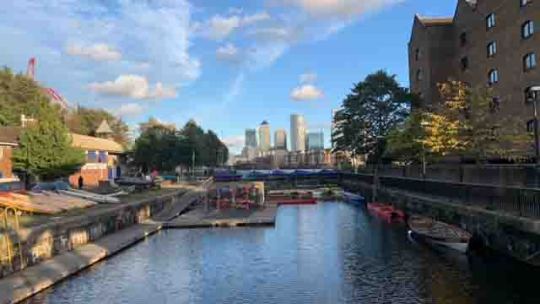
View On WordPress
#All the Vermeers in New York#Casa do Silencio#Clara Jost#Felicidade numa panela#Joanna Pocock#Marilyn Katz#Meine Liebe#Robina Rose#Santiago de Compostela#Surrender#The Mobilization 1968#Weyauwega#Wisconsin
1 note
·
View note
Text
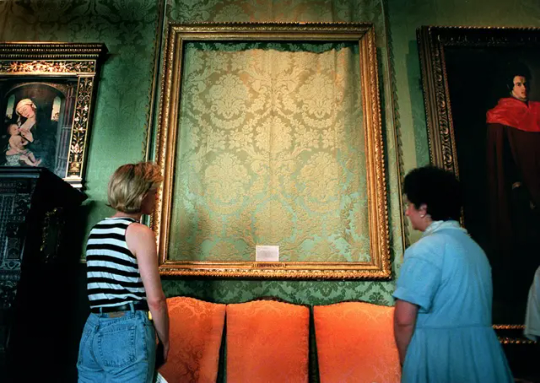
The Isabella Stewart Gardner Museum Theft
Five things you probably didn’t know about the biggest art heist in history
Most art galleries and museums are famous for the art they contain. London��s National Gallery has Van Gogh’s “Sunflowers”; “The Starry Night” meanwhile, is held at The Museum of Modern Art in New York, in good company alongside Salvador Dalì’s melting clocks, Andy Warhol’s soup cans and Frida Kahlo’s self-portrait.
The Isabella Stewart Gardner Museum in Boston, however, is now more famous for the artwork that is not there, or at least, that is no longer there.
On March 18 1990 the museum fell prey to history’s biggest art heist. Thirteen works of art estimated to be worth over half a billion dollars — including three Rembrandts and a Vermeer — were stolen in the middle of the night, while the two security guards sat in the basement bound in duct tape.
The robbery is a treasure trove of surprising facts and unexpected plot twists. Here are five things that make the Isabella Stewart Gardner Museum, and its famous theft, so interesting.
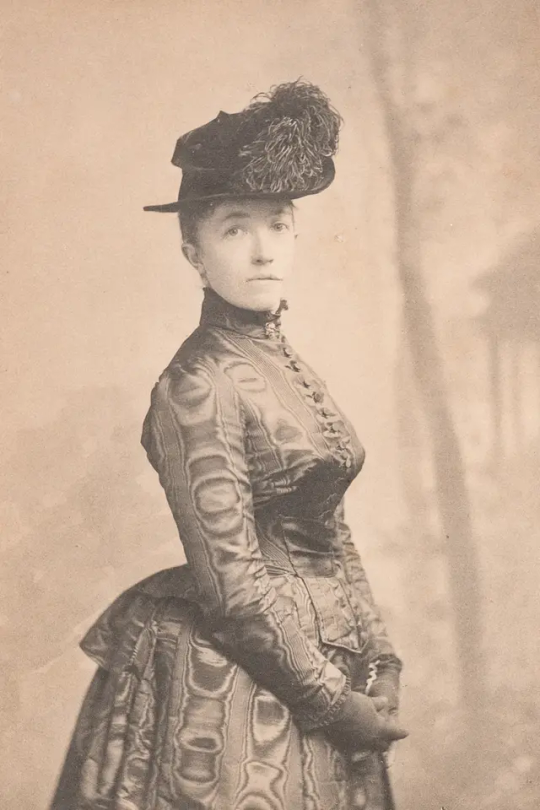
The woman behind the building:
Isabella Stewart Gardner, the museum’s founder and namesake, is a fascinating character. The daughter and eventual widow of two successful businessmen, Gardner was a philanthropist and art collector who built the museum to house her stash.
“When she opened the museum in 1903 she mandated that it be free of charge, to gain the appreciation and the attendance of all of Boston,” Stephan Kurkjian, author of “Master Thieves: The Boston Gangsters Who Pulled Off the World’s Greatest Art Heist”, said in the programme. “Her museum, at that point in time, was the largest collection of art by a private individual in America.”
Gardner also had links to the fledgling campaign for women’s political rights. The museum displays the photographs and letters of her friend Julia Ward Howe, an organizer of two US suffrage societies, and a print of Ethel Smyth, a composer and close friend of the English Suffragette leader Emmeline Pankhurst.
Gardner met Smyth through their mutual friend, the painter John Singer Sargent, whose portrait of Gardener raised eyebrows for the low-cut neckline he gave her.
Gardner seemed to enjoy flirting with scandal and gossip: she once arrived at a Boston Symphony Orchestra performance in a hat band emblazoned with the name of her favorite baseball team, Red Sox, and an illustration in a January 1897 edition of the Boston Globe showed her apparently taking one of Boston Zoo’s lions for a walk.
Somewhat ironically, when the Mona Lisa was stolen in 1911, Gardner told her museum guards that, if they saw anyone trying to rob them, they should shoot to kill.
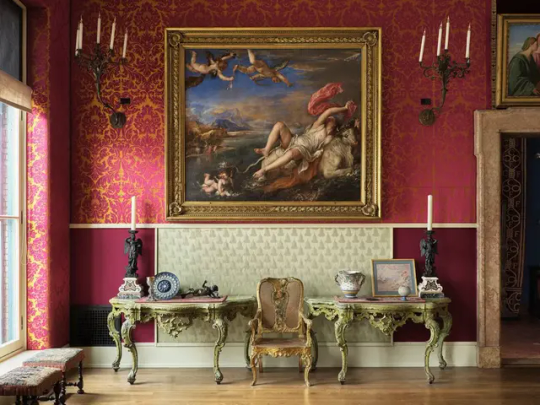
The art not taken:
The thieves’ loot is estimated to be worth over half a billion dollars. However, they left the building’s most expensive artifact: “The Rape of Europa” by Titian, which Gardner bought from a London art gallery in 1896, then a record price for an old master painting.
Why commit history’s greatest art heist and leave without the priciest piece in the museum? Well, size may have played a role. The largest artwork taken was Rembrandt’s “Christ in the Storm on the Sea of Galilee,” famous for being Rembrandt’s only seascape and measures roughly 5x4 feet. “The Rape of Europa,” meanwhile, is larger, at nearly 6x7 feet.
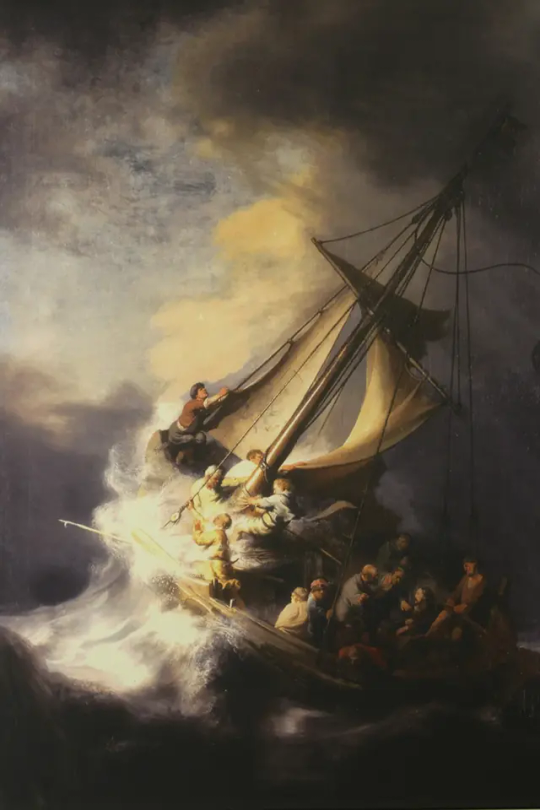
The Napoleon factor:
Around 2005, the investigation into the stolen artworks took a detour to the French island of Corsica in the Meditteranean Sea. Two Frenchmen with alleged ties to the Corsican mob were trying to sell two paintings: a Rembrandt and a Vermeer. Former FBI Special Agent Bob Wittman was involved in a sting to try and buy them — but the operation eventually fell apart when the men were arrested for selling art taken from the Museum of Modern and Contemporary Art in Nice instead.
Why would “Corsican mobsters,” as correspondent Randi Kaye described them in the programme, be interested in robbing a Boston art museum? The answer could lie in the Bronze Eagle Finial, the 10-inch ornament stolen from the top of a Napoleonic flag during the heist.
“It was sort of an odd choice for the thieves to take (the Finial),” Kaye said, “but it turns out that Corsica is essentially the homeland of Napoleon.” The French emperor was born on the island in 1769, and a national museum is now housed in his former family home.
“It is a very compelling notion,” Kelly Horan, Deputy Editor of the Boston Globe, said in the programme, “that a Corsican band of gangsters might have tried to steal back their flag and pull off the entire rest of the heist in the process.”
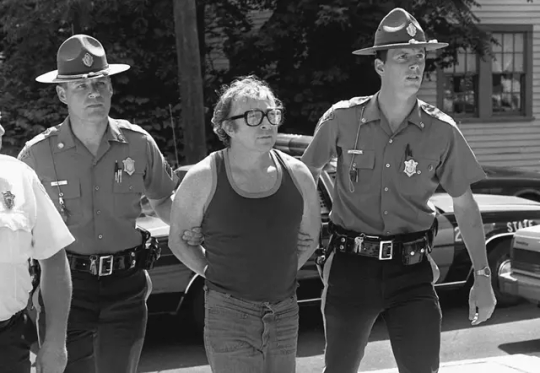
A rock’n’roll suspect:
March 18 1990 was not the first time a Rembrandt had been stolen from a Boston museum. In 1975, career criminal and art thief Myles Connor walked into Boston’s Museum of Fine Arts, and walked out with a Rembrandt tucked into his oversized coat pocket. He was the FBI’s first suspect in the Gardner case, however the walls of federal prison — where he was incarcerated on drugs charges — gave him a pretty solid alibi.
When he wasn’t lifting famous artworks from their displays, Connor was a musician. It was through gigging that he met Al Dotoli, who worked with stars including Frank Sinatra and Liza Minelli.
In 1976 Connor was jailed for a separate art theft committed in Maine. Hoping to use his stolen Rembrandt to leverage a lesser sentence, he needed Dotoli — who was on tour with Dionne Warwick — to turn the painting in to the authorities on his behalf.
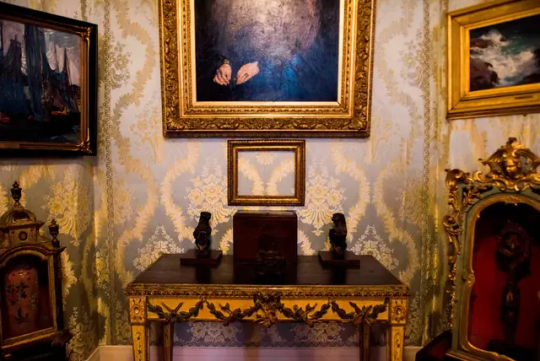
An invisible thief?
One of the stolen artworks, Édouard Manet’s “Chez Tortoni,” was taken from the museum’s Blue Room on the first floor. The painting stands out for two reasons, the first being its frame. The thieves left almost all of the frames behind, cutting some out of the front.
“To even leave remnants of the painting(s) behind was savage,” Horan said. “In my mind, it’s sort of like slashing someone’s throat.”
The “Chez Tortoni” frame was unusual for where it was left, though: not in the room it was stolen from, but in the chair of the security office downstairs. Even more remarkable, not a single motion detector was set off in the Blue Room. Bar investigating the possibility of ghost robbers, investigators wondered if this pointed to the plot being an inside job.
“At the FBI we found that about 89% of museum institutional heists are inside jobs,” Wittman said. “That’s how these things get stolen.”
By Caitlin Chatterton.

#The Isabella Stewart Gardner Museum Theft#The Isabella Stewart Gardner Museum in Boston#Rembrandt#Govert Flinck#Édouard Manet#Johannes Vermeer#Edgar Degas#stolen art#looted art#painter#painting#art#artist#art work#art world#art news#long post#long reads
31 notes
·
View notes
Text

2024 archive of books/films seen
★ = loved ⭑ = liked ⋆ = didn’t care for
Books
★ Independent People (Haldór Laxness) 1934
★ The Fellowship of the Ring (J.R.R. Tolkien) 1954
★ The Two Towers (J.R.R. Tolkien) 1954
★ The Return of the King (J.R.R. Tolkien) 1955
⭑ The Housekeeper and the Professor (Yoko Ogawa) 2003
★ The Handmaid's Tale (Margaret Atwood) 1985
★ Stag’s Leap (Sharon Olds) 2012
⭑ How to Find Love in a Bookshop (Veronica Henry) 2016
★ The Brothers Karamazov (Fyodor Dostoevsky) 1880
⭑ And Then There Were None (Agatha Christie) 1939
★ Holes (Louis Sachar) 1998
Films
★ Come and See (d. Elim Klimov) 1985
⭑ Late Spring (d. Yasujiro Ozu) 1949
⋆ All the Vermeers in New York (d. John Jost) 1990
⋆ Porco Rosso (d. Hayao Miyizaki) 1992
⋆ The Passion of the Christ (d. Mel Gibson) 2004
★ It Happened One Night (d. Frank Capra) 1934
⋆ Jesus Revolution (d. Jon Erwin) 2023
★ LOTR: The Fellowship of the Ring (d. Peter Jackson) 2001
★ LOTR: The Two Towers (d. Peter Jackson) 2002
★ LOTR: The Return of the King (d. Peter Jackson) 2003
⋆ Oppenheimer (d. Christopher Nolan) 2023
⭑ Angel's Egg (d. Mamoru Oshii) 1985
⭑ Mulholland Drive (d. David Lynch) 2001
Shows
★ The Chosen (d. Dallas Jenkins) 2018-
⭑ Tour de France: Unchained (d. Jamie Battento) 2024
★ The Bear (d. Christopher Storer) 2022-

8 notes
·
View notes
Text

Working on...something else. 🤷♀️
Adam had been to the Gardner before.
His first vacation after joining Art Crimes, he'd taken the train to New York City, then Boston. The trio was meant to be educational; in his new unit, he was the only one without an art-related degree. He hadn't even taken a single art class in college. But he tried to catch up. He spent nights and weekends in the plethora of museums in DC. When he'd been sent to Chicago to work a theft from a private collection, he stayed an extra day so he could visit the Art Institute. So when Helen all but mandated Adam use vacation days to get away from work, the easiest option—other than staying in his apartment in Foggy Bottom—had been to take a work-adjacent vacation. He started in New York—at the Met, then MoMA, then the Guggenheim, then the Cloisters—before he finished up in Boston. First the MFA.
Then the Gardner.
By that point, he'd lost track of how many times he'd read the file on the Gardner heist. How many times he'd looked at the photos of the empty gilt frames in the Dutch Room. Seeing them in person was something else though. Photos never got the shade of the room's green brocade wallpaper quite right, nor did they get the right saturation of the light filtering through the shaded windows next to where the stolen Vermeer and Flinck had been displayed back-to-back.
Adam spent a very long time in the Dutch Room on that trip.
He spent even more time in the Dutch Room the morning after he met with Ronan Lynch.
6 notes
·
View notes
Text
Big Galleries Around the World Are Hosting Major Exhibitions
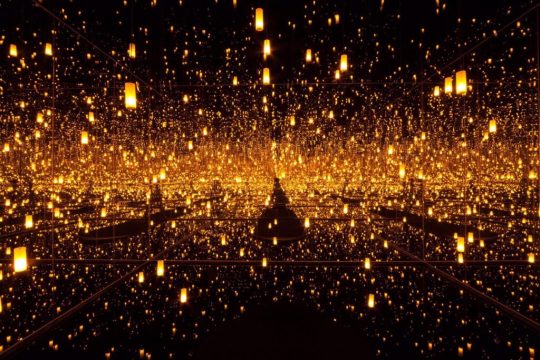
Some of the biggest galleries in the world are hosting major exhibitions this week, featuring works by some of the most famous artists in history. From Jeff Koons's Apollo sculptures in New York City to Yayoi Kusama's mirrored rooms in Los Angeles, there's something for everyone. These are just a few of the many great exhibitions that are happening at the biggest galleries in the world this week. If you're looking for a cultural experience, be sure to check them out! Jeff Koons: Apollo at the DESTE Foundation Project Space in Hydra, Greece. This exhibition features four new sculptures by the iconic American artist, all inspired by the Greek god Apollo. The sculptures are made from materials such as stainless steel, mirror-polished bronze, and polished marble. They are all large-scale and highly reflective, and they create a dazzling visual effect. The exhibition is on view from June 24 to September 17, 2023. Yayoi Kusama: Infinity Mirrors at the Museum of Fine Arts, Houston. This popular exhibition features a series of mirrored rooms filled with Kusama's signature polka dots and infinity patterns. Visitors can step into the rooms and experience the optical illusions created by the mirrors and the patterns. The exhibition is on view from June 25 to September 10, 2023. Picasso and the Allure of Africa at the Museum of Modern Art, New York City. This exhibition explores Picasso's lifelong fascination with African art and its influence on his work. It features over 200 works of art, including paintings, sculptures, and drawings. The exhibition is on view from June 28 to October 9, 2023. Van Gogh: The Immersive Experience at the Lighthouse Artspace in Miami. Van Gogh: The Immersive Experience This digital art exhibition allows visitors to step inside Van Gogh's paintings and experience his work in a whole new way. The exhibition uses projection mapping technology to create a 360-degree experience of Van Gogh's paintings. Visitors can walk through the paintings and feel like they are surrounded by them. The exhibition is on view from June 23 to September 10, 2023. Johannes Vermeer: The Late Works at the National Gallery of Art, Washington, D.C. This exhibition features a selection of Vermeer's most famous paintings from his later years, including "The Girl with the Pearl Earring" and "The Milkmaid." The paintings are all on loan from museums and private collections around the world. The exhibition is on view from June 23 to September 10, 2023. Read the full article
3 notes
·
View notes
Text
2023
This year I visited 178 exhibitions, here is my top ten.

Vermeer, Rijksmuseum, Amsterdam
Perhaps not just an exhibition of the year, but one of a lifetime. Astonishing perfection in every brush stroke; words and reproductions do not capture the empathy contained in every painting that survives by Vermeer. Most of which were brought together at the Rijksmuseum for a truly exceptional exhibition. Unlike so many blockbusters of this type, the paintings did not feel (well ok too crushingly) crowded or overwhelmed by the throngs. Each was given space and a carefully considered semi-circular barrier so visitors could fan out from it. There was little in the way of text panels, no need to contextualise with artworks by other artists; the paintings were each given lots of space in sensitively and richly painted and floor-to-ceiling curtains. They were allowed a dignified space in order to sing to us. I contracted Covid-19 from the trip to Amsterdam which developed into Long-Covid; this left me changed fundamentally as a human as I battle(d) fatigue for months on end. I am still not sure if the impact on my health was worth the trip, but as I write these words I know it was. I will always remember the opportunity to see 28 of the 37 Vermeer’s all in one place at one time.
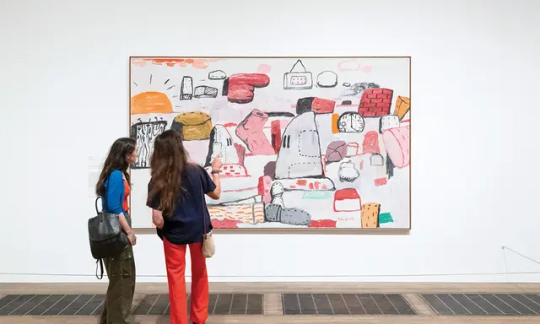
2. Philip Guston, Tate Modern, London
I want to lick and consume Guston’s paintings metaphorically and perhaps even literally, they ingest the eyeballs and linger in the mouth. Seeing the paintings together made so much sense, perhaps the curation sold the narrative but the exhibition made me think that the foray into full-on abstract expressionism was actually the inconsistency; right from the earliest paintings there was story-telling, narrative, figuration, politics, turmoil and a desire to point out what needs to change societally. With the pure abstract works, ambiguity felt too strong, everywhere else the balance was perfect, enough to be led and enough to form your own thoughts. So many works of greatness all together, the final room of grief was as heart-breaking and poetic as it comes.
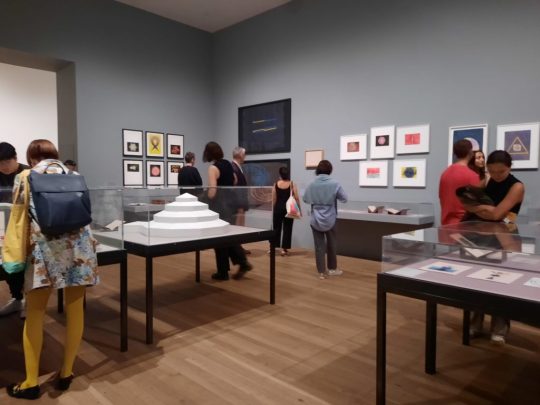
3. Hilma af Klint and Piet Mondrian, Tate Modern, London
This was an exhibition I had to see. I spent weeks preparing for the trip to go and see it. Having Long-Covid meant that I had to conserve and use my energy intensely - when everything saps strength and leaves you exhausted, from having a shower, to walking up stairs to reading a page of a book, then you have to be careful. T0 go to London for the day to see this exhibition was something I trained and equipped myself for/. I was so glad I did. The exhibition made me feel happy and lightness...an injection of art through the eyes which is so good for the soul. af Klint was paired with Mondrian, which made unexpected sense (to me, I know not to others) with so many surprising overlaps such as in their botanical paintings,and more general link to natural forms, the link to Theosophical thought and of course abstraction. One of my favourite rooms in the exhibition was titled the ether and was filled with sketchbooks, books, works by other artists and this amazing model of Mondrian's New York studio.
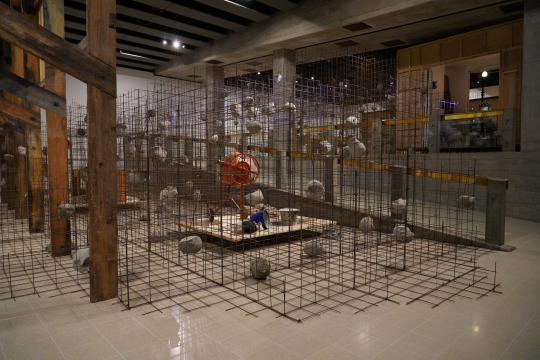
4. Mike Nelson, Hayward Gallery, London
A proper art-as-experience encounter, the atmosphere of being within each of the installations by Nelson, restated at the Hayward was palpable; senses, memories, possibilities spiralled outwards, creating new stories and narratives. An embodied and tacit experience of speculative and to be-found-out-and-created knowledge. A novel or series of novellas contained in a material-led happenstance. This felt like the sort of show a big institution is made for, enabling a coming together of elements that would not be possible in the world without the structure behind it.
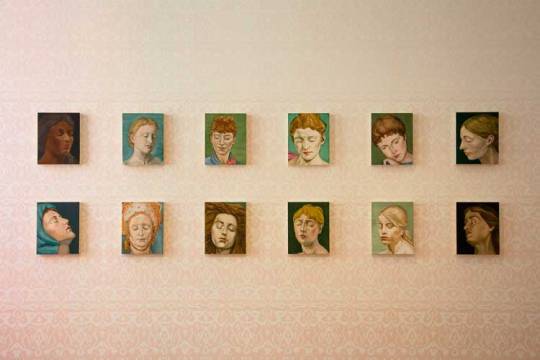
5. Rebecca Fortnum, Henry Moore Institute, Leeds
In many ways the opposite of the behemoth of the shows of the year above; this was a quiet and intimate exhibition of new drawings, paintings and hand-printed wallpaper by Fortnum. The paintings are transcriptions of sculptures by fifteen women who visited or worked at Auguste’s Rodin’s studio. An intention of the work is to offer insight and exposure to these often-overlooked female sculptors. Rodin is known to have trained women to sculpt in the late nineteenth century when they were not allowed to enter into art schools in France, and employed some of them as studio assistants (or the ‘praticienne’ of the show’s title). Many of the women artists that Fortnum has selected to make work from had in what the text panel calls “an extraordinary, and in many cases unpublished, life narrative.” The show also featured drawings of men that were sculpted by the women artists, creating a gendered distinction between female subjects in paint and male subjects in drawings, albeit that the subject of Fortnum’s work is actually the unpictured female artists.
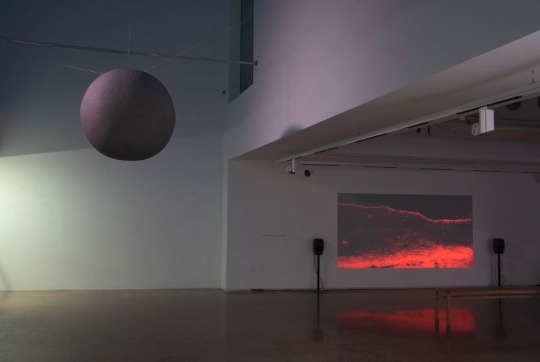
6. Oliver Ventress, Project Space Plus, Lincoln
A beautifully installed coming together of sculpture, sound and video by Ventress that all speculates on what is out there, what might be out there in a delicate oscillation between despair and hope of what our present and future might be. The work beckoned me in quietly, gently insisting that I spend time with it, to slow down by heartbeat to become in line with the tide in one sculpture or the sound emanating from a large grey spherical sculpture (apparently at 210.42hz the theoretical frequency of the moon. With the tuning in to the resonance of the work, came an opportunity to speculate on the future in the present from a position of calm, not panic, all too rare an opportunity in 2023.

7. Chad McCail, Turntable Gallery and tt88
You gotta love a bit of bonkers; a serpentine urban and rural landscape sweeps the carpet tiles on the high street, giants roam the gallery constructed from discarded detritus of the capitalist waste-culture, brains exude from trees and gonzo lizards pelt churches with walnut-like objects. Poke a bit further though and melancholy descends as the worst aspects of humanity seep everywhere: capitalist-greed, paedophilia, and environmental-apocalypse.

8. Brendan Lyons, Bridewell, Liverpool
A joyful form of institutional critique of painting, one rich in materiality. In one gallery several paintings line the walls, completely conventional in description. In one gallery a range of fixings for hanging paintings line the walls, completely conventional in description. That the description is for one and the same gallery is the magic of Lyons work. Each fixing has been constructed fully from paint, being both itself and a simulacra of the hidden elements of painting, an opening up and unlocking. In the other gallery three new pieces are bold in the way the first gallery is subtle. Ivy creeps down the walls and over canvas; parcel tape tries to fix a smashed glass of an empty frame; multiple blank canvas are tapped to the wall with Gaffa and parcel tape…or look a bit closer.
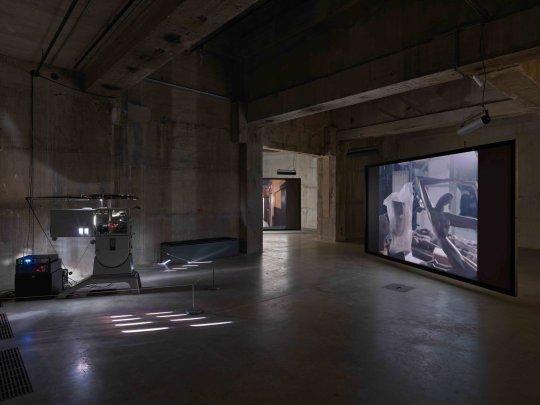
9. Rosa Barba, Tate Modern, London
The Tanks at Tate Modern are a brilliant space to encounter Barba’s work; the atmosphere of the space evokes the type of places the artist is attracted too, places that are pregnant with a past. 3 35mm film installations affectingly occupy the space, the visuals draw you in, the sound quivers with the image, but perhaps most evocatively the projectors percolate all the space in their industriousness that comes close to humanity in their presence.
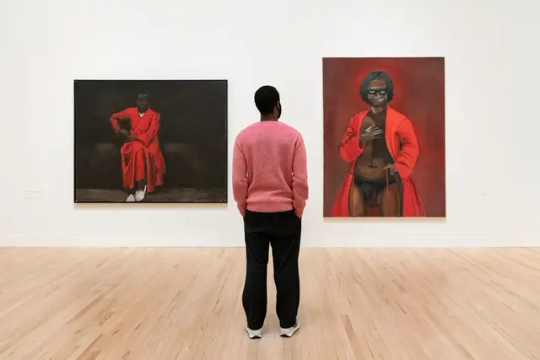
10. Lynette Yiadom Boakye, Tate Britain, London
I could have had several number tens on this list, significantly I whittled a shortlist down to five, all of which were painting exhibitions. So why does Yiadim Boayake become number ten? Perhaps it is the way she handles paint, something I wish I could inhabit? Or perhaps it is the way she creates stories with paints? Or perhaps it is the way she conjures personal lives, and memories of histories in the people she paints from imagination? Perhaps it is the way she invents archetypes for our time in the presence of the people? Or perhaps it is because I want to look, to spend time, to look harder, nearer, closer, more attentively? Or perhaps it is because I struggle with the words, the paintings do what (my) words can’t, reach the soul.
In 2023 I visited the following exhibitions:
30 December, Pesellino, National Gallery, London
30 December, Discover Liotard and the Lavergne Family Breakfast, National Gallery, London
15 December, Corrupt Vision, General Practice, Lincoln
15 December, Sam Scorer, Usher Gallery, Lincoln
30 November, 8 Acts of Love, Project Space Plus, Lincoln
24 November, Made in Scunthorpe, Fountain Arts, Scunthorpe
24 November, Glow Up , 2021, Scunthorpe
24 November, Swords into Ploughshares: Knives into Jewels, 2021, Scunthorpe
17 November, Daniel Richter, Thaddaeus Ropac, London
17 November, Endless Variations, Ordovas, London
7 November, Avery Singer, Hauser & Wirth, London
7 November, Christina Quarles, Pilar CorriasLondon
7 November, It All Starts With a Thread, Whitechapel Gallery, London
7 November, Anna Mendelssohn, Whitechapel Gallery, London
7 November, Johanna Billing, Whitechapel Gallery, London
7 November, Nicole Eisenmann, Whitechapel Gallery, London
7 November, In the Studio, Tate Modern, London
7 November, El Anatsui, Tate Modern, London
7 November, Phillip Guston, Tate Modern, London
7 November, Joan Mitchell, Tate Modern, London
14 November, Tread Softly, Gloam, Sheffield
14 November, Paul Housely, Persistence Works, Sheffield
14 November, Autumn Almanac III, Persistence Works, Sheffield
13 November, Nature Positive, Project Space Plus, Lincoln
27 October, Tim Murray-Browne, St. Marks, Lincoln
27 October, Maria Mavropoulou, St. Mary Le Whigford, Lincoln
27 October, Beccy McCray Engine Shed, Lincoln
27 October, Filthy Luker, Lincoln
27 October, Camille Baker, The Drill, Lincoln
27 October, Lumo Workshop and The Network, Lincoln
27 October, Dangerous Times, Lincoln
27 October, Lauren Hubbard, Waterstones, Lincoln
27 October, Touch & Glow, St. Marks,Lincoln
27 October, Marc Renshaw, Wealth Streams Development Agency, Gainsborough
24 October, John Dowling, Link Corridor, Lincoln
24 October, Birth and Design 23, Project Space Plus, Lincoln
21 October, Creativity Unlocked, Salthouse, Lincoln
21 October, Sam Tahmassebi and Harrison Taylor, Cornhill, Lincoln
21 October, Soft Egg, Don't Wear It, Salthouse, Lincoln
21 October, Unweeded, General Practice, Lincoln
21 October, Tyler Barker, Zara Sands, Walking Together, The Collection, Lincoln
21 October, Past and Present Practice, St Mary Le Whigford, Lincoln
21 October, SLQS - Straight from the Horses Mouth, St Mary Le Whigford, Lincoln
21 October, In My Perfect State, Cornhill, Lincoln
20th October, Artists in the Now, The Link Up, Limcoln
19 October, Obscene Pomegranate, Salt House, Lincoln
19 October, Gurminder Sikand, Trace, Nottingham
14 October, Nahem Shoa, Walker Art Gallery, Liverpool
14 October, John Moores Painting Prize, Walker Art Gallery, Liverpool
14 October, Tom Wood, Walker Art Gallery, Liverpool
14 October, Tim Spooner, Bluecoat, Liverpool
14 October, Brendan Lyons, Bridewell, Liverpool
14 October, About Face, 50_MV, Liverpool
14 October, Anthony Gormley, Crosby beach, , Liverpool
6th October, Grayson Perry, Lincoln Museum
6th October, Oliver Ventress, Project Space Plus, Lincoln
28 September, Ridykeulous (Nicole Eisenman & A.L. Steiner, with Sam Roeck): Ridykes’ Cavern of Fine Inverted Wines and Deviant Videos, Nottingham Contemporary
28 September, Green Unseen, Dajongly Gallery, Nottingham
28 September, Reimagining the Victorians, Dajongly Gallery, Nottingham
28, Community Choice, Usher Gallery, Lincoln
21 September, Method Lab 3, Trace Gallery, Nottingham
21 September, John Becka nd Matthew Cornford, Bonnington Gallery, Nottingham
21 September, Art (School) Histories, Bonnington Gallery, Nottingham
16 September, Chad McCail, Turntable Gallery
16 September, Chad McCail, Turntable 88 Gallery
10 September, Mark Judson, the hub, Sleaford
10 September, Together we are Powerful, the hub, Sleaford
10 September,Adaesi Ukairo, the hub, Sleaford
9, September, George Boole School, Lincoln Museum
9, September, CODED: Digital Art that Defies Definition, Lincoln Museum
8 September, MA Fine Art, University of Northampton
1 September, The Power of Printed Matter, Beam, Nottingham
27 August, A Sense of Place, Willoughby Memorial Gallery, Corbey Glenn
25 August, Bare, Project Space Plus, Lincoln
24 August, Strange Friends, Hauser and Wirth, London
24 August, Connect, Reveal, Conceal, Hauser and Wirth, London
24 August, Holding Space, Hauser and Wirth, London
24 August, To Bend the Ear of the Outer World: Conversations on contemporary abstract painting, Gagosian, London
24 August, Glenn Brown, The Brown Collection, London
24 August, The Belly and the Guts, Alice Amati, London
24 August, Tomas Saraceno, Serpentine Gallery, London
24 August, Lina Ghotmeh, Serpentine Gallery, London
24 August, Gabriel Massan, Serpentine Gallery, London
24 August, Atta Kwami, Serpentine Gallery, London
24 August, Matthew Collings, Wellington Arch, London
24 August, Summer Show, Skarstedt, London
24 August, Malediction and Prayer, Modern Art, London
24 August, Moki Cherry, ICA, London
24 August, Samson Kambalu, London
24 August, Nira Pereg, Tate Modern, London
24 August, Vivian Sundaram, Tate Modern, London
24 August, Jannis Kounellis, Tate Modern, London
24 August, Rosa Barba, Tate Modern, London
24 August, Rasheed Araeen, Tate Modern, London
24 August, Art and Text, Tate Modern, London
24 August, Lawrence Weiner, Tate Modern, London
24 August, Hilma af Klint and Piet Mondrian, Tate Modern, London
10th August, Erwin Wurm, Yorkshire Sculpture Park
10th August, Lindsey Mendrick, Yorkshire Sculpture Park
10th August, Leonardo Drew, Yorkshire Sculpture Park
10th August, Catriona Robertson, Art House, Wakefield
10th August, The Royal Society of Sculptors presents: The Gilbert Bayes Award, Art House, Wakefield
10th August, Tony Wade, Art House, Wakefield
10th August, The Art of the Potter: Ceramics and Sculpture from 1930 to Now, Hepworth, Wakefield
10th August, If Not Now, When? Generations of Women in Sculpture in Britain, 1960 – 2022, Hepworth, Wakefield
10th August, Hurvin Anderson Curates, Hepworth, Wakefield
10th August, Hurvin Anderson, Hepworth, Wakefield
25, July, Kresiah Mukwazhi: Kirawa, Nottingham Contemporary
25, July, Abbas Zahedi: Holding a Heart in Artifice, Nottingham Contemporary
25, July, Eva Koťátková: How many giraffes are in the air we breathe? , Nottingham Contemporary
25, July, Jade Foster, TG, Nottingham
25, July, Line Nielsen, Beam, Nottingham
25, July, Residents & Members | Video Materials, Primary, Nottingham
25, July, Sam Keogh, Primary, Nottingham
21 July, The Weight of Words, Henry Moore Institute, Leeds
21 July, Egon Altdorf, Henry Moore Institute, Leeds
21 July, Things Left Unsaid: Percy Wyndham Lewis, Iris Barry, Helen Saunders and the story of Praxitella, Leeds Art Gallery
7th July, Patrick Hartigan, Moon Grove, Manchester
7th July, Office of Arte Útil, Whitworth Art Gallery, Manchester
7th July, Standardisation and Deviation The Whitworth Story, Whitworth Art Gallery, Manchester
7th July, (Un)defining Queer, Whitworth Art Gallery, Manchester
7th July, Traces of Displacement, Whitworth Art Gallery, Manchester
7th July, Albrecht Durer, Whitworth Art Gallery, Manchester
7th July, Economics the Blockbuster – It’s not Business as Usual, Whitworth Art Gallery, Manchester
7th July, Tino Sehgal, Whitworth Art Gallery, Manchester
7th July, The Poetics of Water, Castlefield Gallery, Manchester
7th July, Yaoi Kusama, Factory International, Manchester
7th July, What's New?, Manchester Art Gallery
7th July, Friends, Family and Other Animals, Manchester Art Gallery
7th July, Rethinking the Grand Tour, Manchester Art Gallery
7th July, Room to Breathe, Manchester Art Gallery
7th July, Climate Justice, Manchester Art Gallery
7th July, Trading Station, Manchester Art Gallery
7th July, Suzanne Lacy, Manchester Art Gallery
7th July, Out of the Crate, Manchester Art Gallery
11 June, Demo Valley, Peter de Wint building, Lincoln
3 June, Sonia Boyce, Leeds Art Gallery
20 May,Opera North: Race, Representation and Authenticity, 1979–2023, The Stanley & Audrey Burton Gallery, Leeds
20 May, Arcadia for All? Rethinking Landscape Painting Now, The Stanley & Audrey Burton Gallery, Leeds
20 May, Andrew Black, The Tetley, Leeds
20 May, Samra Mayanja, The Tetley, Leeds
20 May, Rebecca Fortnum, Henry Moore Institute, Leeds
20 May, Michael E Smith, Henry Moore Institute, Leeds
19 May, Re:Collection, Lincoln Museum
26 March, Vermeer, Rijksmuseum, Amsterdam
26 March, Rijksmuseum & Slavery, Rijksmuseum, Amsterdam
26 March, Operation Night Watch, Rijksmuseum, Amsterdam
25 March, Choosing Vincent, Van Gogh Museum, Amsterdam
25 March, Titus is Back Home ,Rembrant House, Amsterdam
25 March, The Art of Drawing,Rembrant House, Amsterdam
24 March, Visitant Queens, Project Space Plus, Lincoln
19 March, Charlotte Johnnesson, Nottingham contemporary
19 March, Carolyn Lazzard, Nottingham contemporary
19 March, Rosalind Nasashibi, Nottingham Contemporary
19 March, A Commonplace, Nottingham Contemporary
Helen Dearnley, St Mary le Whigford, Lincoln
18 March, Annie Morrad and Joana Coffee Cerda, Cornhill, Lincoln
13 March, Blubber, General Practice, Lincoln
26 February, Harriet Plewis, General Practice, Lincoln
24 February, Peter Doig, Courtaud Gallery, London
24 February, John Akomfrah, Tate Britain, London
24 February, Haroon Mirza, Lisson Gallery London
24 February, Lines of Empathy, Patrick Heide Gallery, London
24 February, Atiena R. Kilfa, Camden Arts Centre, London
24 February, Mohamed Sami, Camden Arts Centre, London
24 February, Hannah Quinlan and Rosie Hastings, Tate Britain, London
24 February, Aubery Williams, Tate Britain, London
24 February, Lynette Yiadim Boayake, Tate Britain, London
24 February, Ingela Ihrman, Gasworks, London
24 February, group show, Corvi Mora, London
24 February, Nakeya Brown, Greengrassi, London
24 February, Mike Nelson, Hayward Gallery, London
19 February, Horror in the Modernist Block, Ikon Gallery, Birmingham
10th February, Twin Realms, General Practice, Lincoln
27th January, Kai Speed and H.Eaven, General Practice, Lincoln
27th January, David Remfrey, Usher Gallery, Lincoln
20th January, Hollow Earth, Nottingham Contemporary
16th January, Bodies of Practice, Project Space Plus, Lincoln
2 notes
·
View notes
Text
research for character development and environment design
i want the cupboard to be littered with items the defined the decades that the pair have lived through but also to have some famous stolen or reported missing artefacts in from over the years.
Museum of Natural History Heist (1964)
New York Museum of Natural History, making off with priceless gems, including the 563-carat Star of India sapphire, the 100-carat DeLong Star Ruby and the 116-carat Midnight Star black sapphire.
Fake Cops Loot the Gardner Museum (1990)
Visitors to the Isabella Stewart Gardner Museum in Boston now can only view a framed section of fabric wall where Rembrandt van Rijn's 'The Storm on the Sea of Galilee' used to hang. It was one of 13 valuable paintings stolen in a mysterious heist that remains unsolved.
made off with 13 works of art, including paintings by Rembrandt van Rijn, Johannes Vermeer, Edgar Degas and Édouard Manet.
'The Scream' Goes AWOL, Twice (1994 and 2004)
It’s a good thing the Norwegian painter Edvard Munch created several iterations of his most famous work, “The Scream,” since two of them have fallen into the hands of art thieves. First, in February 1994, burglars scaled a ladder and broke a window of the National Museum in Oslo, stealing its version of the iconic painting. They left behind a note that read, “Thanks for the poor security” and later demanded $1 million in ransom.. In August 2004, two masked robbers entered Oslo’s Munch Museum, holding tourists and employees at gunpoint as they tore another version of “The Scream” as well as Munch’s painting “The Madonna” off the wall.
Sweden’s National Museum Loses Two Renoirs and a Rembrandt (2000)
the National Museum of Fine Arts in Stockholm. filched two paintings by Pierre-Auguste Renoir and one by Rembrandt. Meanwhile,
Whitworth Art Gallery Treasures Wind Up Behind the Loo (2003)
Three paintings by Picasso, Vincent Van Gogh and Paul Gauguin, collectively worth an estimated $1.6 million at the time, spent a rainy night behind a boarded-up outdoor public bathroom after vanishing from the nearby Whitworth Art Gallery in Manchester, England on April 26, 2003.
Bogus Tourists Lift 'Madonna of the Yarnwinder' (2003)
In August 2003, two thieves posing as tourists plucked the “Madonna of the Yarnwinder,” (1501), a Renaissance masterpiece believed to have been painted by Leonardo da Vinci and worth tens of millions of dollars, off a wall of Scotland’s Drumlanrig Castle,
tuckers cross (1975) -
made off with 13 works of art, including paintings by Rembrandt van Rijn, Johannes Vermeer, Edgar Degas and Édouard Manet.
Antwerp diamond heist (2003)-
Diamonds, gold and other jewels worth $189 million. Dubbed the "heist of the century".
After doing some research i think I'm going to use tuckers cross, the two renoirs and a renbrant stolen from the National Museum of Fine Arts in Stockholm, both scream paintings and Rembrandt van Rijn's 'The Storm on the Sea of Galilee' from the Isabella Stewart Gardner Museum in Boston with the peice of cloth missing.
whilst taking to class mates, they suggested i add other missing artifacts like the sphinx nose.
i might also include some items that aren't reported stolen or missing to suggest that they've been replaced with a fake.
0 notes
Text

I. INTRODUCTION -- there's a witch in the woods..
⟨ brenton thwaites, he/him, 33 ⟩ as ⟨ aaron bear ⟩. often to be found ⟨ at the hospital ⟩. Where else would he be? Who's he loyal to? ⟨ Nobody⟩? Careful, or he paints you blue in an instant. as written and tortured by– ⟨ river, she/they, utc, eating disorders ⟩
II. HEADCANONS -- is it the echo or the answer?
Name: Aaron Grayson Wesley Bear Occupation: Pediatric Surgeon Age: 33 Sexuality: Pansexual Species: Witch Clan/Pack/Coven?: currently none Hometown: Port Leiry / New York Relationship Status: Arranged engagement (unhappily) Family: Wesley Batholomew Archibald Bear (Father), Catherine Constance Amelia Bear (Mother)
III. BIOGRAPHY -- shatter me.
The calming tick, tick of a watch comes close enough to the sound of a metronome (his favorite -- which is stored away somewhere on the attic, forever fucking lost). Maybe that's why watches are the only expensive allowance he grants his father to gift him, which he allows as presents. Hublot. Bucherer. Vacheron Constantin. They all don't quite compare to Bach, Wagner, Haydn. Following the rhythmic tick, tick, doesn't quite feel the same as tapping the keys of a piano. Not that music was his passion, ever. Not that his next obsession, art was -- Munch, Pollock, Rembrandt, and his favorite, Vermeer. The Mauritshuis is gorgeous, and so is Meisje met de parel, but Aaron never finds himself capturing her full beauty, with the looming hand of his father held over his shoulder. Every form of art he chooses to adore, to obsess with, is always followed up with a Let's go. Let's move on.
And so he does.
Aaron always moves on. Until he finds something so sacred, that the words Move on become imaginary. Fake. Fantasy. There's no moving on if his heart is stuck admiring the same piece of art over again -- no, wrong. He finds him in every piece of art. In every song. In every watch, in every color, in every room.
His colorful, chaotic world that was all polished out as he grew, became one, shining sea of color. Gone was the white marble and waxed desks, arrived had the paint sprinkles and mess and -- Rivan.
A sacred, little secret. Some servants find out, but they keep it a secret for him, and Aaron moves through fundraisers, through dinners and banquets, through Highschool, and pre-med, and then medical school. Rivan is somehow always there, and never quite vanishes. No drop of Liberon or Strypit or Colron can get him off -- and Aaron tries, like a madman, tries to get rid of him.
It doesn't work. It never does.
Let's move on becomes please stay, even drenched in the ugliest of all colors, red; even on his knees, next to a body; even on the graveyard, at a funeral. Even on benches in winter, in the sea in summer, in the hospital during a particularly hard shift.
Aaron can't let him go.
But the engagement contract he signs for Freyja yells, screams, LET'S MOVE THE FUCK ON.
Aaron looks back at the painting -- and figures out a name.
'The greatest betrayal'.
1 note
·
View note
Text
Arnold Newman
After some of the initial research into portraits at the beginning of the semester by Pernille Sandberg I came across Arnold Newman and particular his envrionmental portraits of pianists and artists who's profession was sitting with these beautiful instruments.
I was taken back by how he composed the portrait, making the piano as much of a focal point but also obselete with little to no detail. The contrast and impact it has is quite striking. The vermeer lighting on Stravinsky's face adds to the contrast in the rest of the image that is largely flat areas of black and grey space.
One type of portrait photography that I have always loved is black and white - as the classic view of it goes 'it transcends time' - though there are elements of style that are embued with photographs their transcendance of time is what liberates them. Which is something i really like in the environmental or close up portraits like i looked at of Rebecca Naen, Leanne Surfleet, Pernille Sandberg and Mia Sakai.

Igor Stravinsky, New York, NY, 1 December 1946
Noted for his ‘environmental portraits’, Newman photographed his subjects in settings which reflected their profession and captured them in situ – from Jackson Pollock in his studio, to Arthur Miller pictured backstage at the theatre. One of the artist’s most known photographs pictures the Russian composer Igor Stravinsky sitting at a grand piano. In this portrait, the object of the sitter’s profession takes centre stage, nearly filling the image, while Stravinsky himself takes a seat in the corner.
Newman’s choice of a white background, along with his use of black and white film and angle, all work together to subtly nod towards the sitter’s character and profession. He stages the image in a way which causes the lid of the piano loses its depth, taking the form of an abstract shape which closely resembles a music note. The music note dramatically looms over the composer, embodying Stravinsky’s life’s work.
Newman said of his sitters, “it is what they are, not who they are, that fascinates me”. In this portrait, the sitter and his profession merge. Through his ‘environmental portrait’, Newman creates an image which visualises the scale of Stravinsky’s talent and fame
1 note
·
View note
Text

I listened to this podcast again today, and posted Binstock's 2013 timeline of Vermeer's works, with the "misfit" paintings —those whose attribution or quality or whatever has already been problematic for scholars in some way— highlighted in red. It seems wild to say that makes them all Maria Vermeers, and I don't think that's necessarily what he's done. Unless?

A podcast where Lawrence Weschler talks about Benjamin Binstock's strongly ignored theory that several paintings attributed to Johannes Vermeer, including most of the Vermeers in the US, were actually painted by his daughter Maria, who was also, Binstock argues, along with many others, the model for Girl with Pearl Earring.

After some unprecedented covid-era scientific analysis, the National Gallery of Art reattributed their painting, Girl with a Flute, to an assistant in the artist's studio. It's painted on a panel like their other Vermeer, above, Girl with a Red Hat, and seems to show the same model. That, Binstock argues, is because they are both selfies by Maria.
241 notes
·
View notes
Text
Explore the Wonders of the Metropolitan Museum of Art
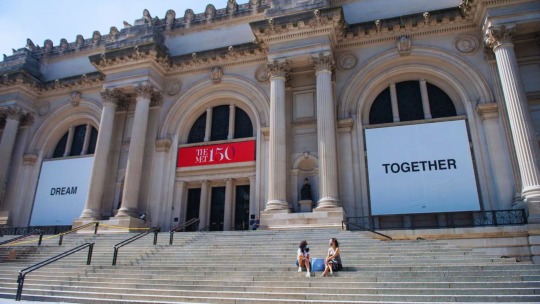
Explore the cultural tapestry woven at the Metropolitan Museum of Art, a sanctuary of artistic brilliance in the heart of New York City. Unearth the treasures of human history spanning 5,000 years, as we embark on a visual odyssey through this iconic institution.
Egyptian Splendors: A Glimpse into Ancient Mysteries
Delve into the enigmatic world of Egypt with the Metropolitan Museum's captivating Egyptian Art collection. Mummies, hieroglyphs, and artifacts from a bygone era await, with the Temple of Dendur standing as a testament to ancient craftsmanship and architectural grandeur.
European Elegance: A Canvas of Timeless Masterpieces
Immerse yourself in the richness of European art as you traverse the halls adorned with masterpieces by Rembrandt, Vermeer, and Van Gogh. From the Renaissance to the Impressionist era, witness the evolution of artistic expression in the European Paintings collection.
American Tapestry: Chronicles of a Nation's Artistic Journey
The American Wing invites you to witness the unfolding narrative of American art, from colonial times to the present day. Iconic works like Emanuel Leutze's "Washington Crossing the Delaware" and sculptures by Augustus Saint-Gaudens punctuate this chronicle of creativity.
Eastern Elegance: A Panorama of Asian Artistry
Embark on a journey through the East with the Asian Art department, showcasing a breathtaking array of artifacts from China, Japan, and Korea. From ancient ceramics to contemporary installations, the collection provides a comprehensive view of Asian artistic traditions.
Time Travel at The Met Cloisters: A Medieval Escape
Step into the ethereal realm of The Met Cloisters, nestled in Fort Tryon Park. This medieval European haven offers a unique experience surrounded by art and architecture from a bygone era. Gardens, chapels, and cloisters beckon, creating a serene atmosphere.
Beyond Art: A Symphony of Decorative Arts and More
The Met goes beyond conventional art forms, housing an impressive collection of decorative arts, textiles, and musical instruments. Explore the diversity within the museum's walls, where every corner reveals a new facet of human creativity.
Dynamic Presentations: Special Exhibitions and Educational Initiatives
The Met constantly evolves with special exhibitions that illuminate specific themes, artists, or periods. These exhibits provide a fresh lens through which to view rare and extraordinary pieces, ensuring a dynamic and ever-changing experience for visitors.
Education Hub: Nurturing Art Enthusiasts of All Ages
The Met's commitment to education is evident in its diverse programs and resources. From guided tours to online exhibits, the museum strives to make art accessible and engaging. Conservation efforts ensure the preservation of delicate artworks, fostering a cultural legacy.
Central Park Reverie: A Post-Art Stroll
Situated on the edge of Central Park, the Met offers not just a cultural feast but also a picturesque setting. After exploring the vast galleries, take a leisurely stroll through the park, reflecting on the beauty encountered within the museum's walls.
In conclusion, the Metropolitan Museum of Art is a cultural beacon that captivates and inspires. Its commitment to preserving, presenting, and educating about art makes it an enriching destination. Whether you're a seasoned art connoisseur or a casual observer, a visit to the Met promises an unforgettable journey through the wonders of human creativity.
1 note
·
View note
Text
Holidays 10.31
Holidays
American Indian Day (Tennessee)
Bitcoin Day
Day of Local Songs (Peru)
Day of the 7 Billion
Día de la Canción Criolla (Peru)
Girl Scout Founder’s Day
International Black Sea Action Day
John Candy Day (Toronto, Canada)
King Father’s Day (Cambodia)
Martyr’s Day (Burkina Faso)
Medusa Day
Mount Rushmore Day
National Bug Busting Day (UK)
National Evangelism Day
National Prince Day
National Unity Day (India)
Non-Working Day (Russia)
Phi Day
Plough Tree Day (French Republic)
Rabbit Rabbit Day [Last Day of Every Month]
Reformation Day (Slovenia)
Senior Absurdity Day (Bronx, NY)
Spider-Girl Day
World Cities Day (UN)
World Savings Day
World Thrift Day (India)
Youth Honor Day (Iowa)
Food & Drink Celebrations
Billy Beer Day (Plains, Georgia)
Brewtopia (NYC)
International Day of Rice
Japanese Tea Day (Japan)
National Caramel Apple Day
National Keg Day
The United Nations of Beer (New York)
5th & Last Tuesday in October
Mix It Up at Lunch Day [Last Tuesday]
Independence Days
Edan (Declared; 1999) [unrecognized]
Nevada Statehood Day (#36; 1864)
Wellington (Declared; 2009) [unrecognized]
Feast Days
Abaidas (Coptic Church)
Alphonsus Rodriguez (Christian; Saint)
Ampliatus (Christian; Saint)
Begu (Christian; Saint)
Bob Crane Day (Church of the SubGenius; Saint)
Erc of Slane (in Cornwall; Christian; Saint)
Feast of Sekhmet Bast Ra (Ancient Egypt)
Felix the Chicken (Muppetism)
Festival of Inner Worlds
Foillan (in Namur; Christian; Saint)
Gerbil Caressing Day (Pastafarian)
Hallowe’en (also celebrated as ...
Allantide (Cornwall, UK)
All Hallows Eve
Apple and Candle Night (Wales)
Beggar's Night
Beltaine [Southern Hemisphere; begins at sunset]
Books For Treats Day
Caramel Apple Day
Carve a Pumpkin Day
Chiang Kai-Shek Day (Taiwan)
Day of the Dead begins (Mexico) [until 11.2]
Dookie Apple Night (Newcastle, UK)
Duck Apple Night (Liverpool, UK)
Fright Night (Pastafarian)
Ghostwriter’s Day
Halloween
Hop-tu-Naa (Isle of Man)
Increase Your Psychic Powers Day
National Doorbell Day
National Dress Like a Slut Day
National Keg Day
National Knock-Knock Joke Day
National Magic Day
National UNICEF Day
Night of a Thousand Screams (Church of the SubGenius; Saint)
Nut-Crack Night (UK)
Out of the Broom Closet Day
Saci Day (Brazil)
Samhain [Northern Hemisphere; begins at sunset]
Samhain Eve (Celtic, Pagan) [7 of 8 Festivals of the Natural Year]
Scare a Friend Day
Sneak Some of the Candy Before the Kids Start Knocking Day
Thump-the-Door Night (Isle of Man)
Trick or Treat Night
Isis/Osiris Mysteries IV (Pagan)
Johannes Vermeer (Artology)
Kant (Positivist; Saint)
Makoshe’s Holiday (Asatru/Pagan Slavic celebration of Mother Earth)
Marie Laurencin (Artology)
Martin Luther (Anglican Communion)
Meindert Hobbema (Artology)
Old Celtic New Year’s Eve
Paul Shinji Sasaki and Philip Lindel Tsen (Episcopal Church)
Reformation Day (Germany, Slovenia, Lutheran Church)
Quentin (Christian; Saint)
Theodore Romzha, Blessed (Ruthenian Catholic Church)
Vetmaetr (Norse beginning of winter, start of Odin leading the Wild Hunt)
Wolfgang of Regensburg (Christian; Saint) [Germany]
Lucky & Unlucky Days
Sensho (先勝 Japan) [Good luck in the morning, bad luck in the afternoon.]
Uncyclopedia Bad to Be Born Today (because it’s Xt'Tapalatakettle's Day.)
Unfortunate Day (Pagan) [51 of 57]
Premieres
The Adventures of Sherlock Holmes, by Arthur Conan Doyle (Novel; 1892)
All Wet (Disney Cartoon; 1927)
Ash vs. Evil Dead (Film; 2015)
Bohemian Rhapsody, by Queen (Song; 1975)
Catty Cornered (WB MM Cartoon; 1953)
The Country Cousin (Disney Cartoon; 1936)
Explosive Situation or Don’t Make It Worse — It’s Badenov (Rocky & Bullwinkle Cartoon, S3, Ep. 121; 1961)
Foul Hunting (Disney Cartoon; 1947)
Girls! Girls! Girls! (Film; 1960) [Elvis Presley #11]
I Only Have Eyes For You, recorded by The Flamingos (Song; 1958)
Like a Virgin, by Madonna (Song; 1984)
Livin’ on a Prayer, by Bon Jovi (Song; 1986)
A Modest Proposal, by Jonathan Swift (Essay; 1726)
Ninety-Five Theses, by Martin Luther (Pamphlet; 1517)
Period of Adjustment (Film; 1962)
The Red Sea Sharks, by Hergé (Graphic Novel; 1958) [Tintin #19]
The Secret Teachings of All Ages, by Manly P. Hall (Book; 1928)
Somebody Stole My Gal, recorded by Count Basie (Song; 1930)
Spellbound (Film; 1945)
Star Dust, recorded by Hoagy Carmichael (Song; 1927)
Strategy, by B.H. Liddell Hart (Book; 1929)
Two Weeks Vacation (Disney Cartoon; 1952)
Unplugged MTV Show, recorded by Squeeze Live Show; 1989) [1st Unplugged Show]
The Walking Dead (TV Series; 2010)
What Ever Happened to Baby Jane (Film; 1962)
A Witch’s Tangled Hare (WB LT Cartoon; 1959)
You’ve Got Me in Switches or Suture Self (Rocky & Bullwinkle Cartoon, S3, Ep. 122; 1961)
Zack and Miri Make a Porno (Film; 2008)
Today’s Name Days
Christoph, Quentin, Wolfgang (Austria)
Alfons, Volfgang, Vukmir (Croatia)
Štěpánka (Czech Republic)
Louise (Denmark)
Ardo, Ardu, Arti, Arto, Artur (Estonia)
Arto, Arttu, Artturi (Finland)
Quentin (France)
Melanie, Quentin, Wolfgang (Germany)
Ablia, Apellis, Aristovoulos, Narkisos, Stratoniki (Greece)
Farkas (Hungary)
Lucilla (Italy)
Rinalds, Smilga, Valts, Volfgangs (Latvia)
Alfonsas, Liucilė, Tanvilė (Lithuania)
Edit, Edna (Norway)
Alfons, Alfonsyna, Antoni, Antonina, August, Augusta, Godzimir, Godzisz, Lucylla, Łukasz, Saturnin, Saturnina, Urban, Wolfgang (Poland)
Amplie, Afelie, Aristobul, Narcis, Stahie, Urban (Romania)
Aurélia (Slovakia)
Alonso, Quintín (Spain)
Edgar, Edit (Sweden)
Maura, Moira (Ukraine)
Cruz, Flint, Flynn, Kruz, Trent, Trenton (USA)
Today is Also…
Day of Year: Day 304 of 2024; 61 days remaining in the year
ISO: Day 2 of week 44 of 2023
Celtic Tree Calendar: Ngetal (Reed) [Day 1 of 28]
Chinese: Month 9 (Ten-Xu), Day 17 (Ren-Xu)
Chinese Year of the: Rabbit 4721 (until February 10, 2024)
Hebrew: 16 Heshvan 5784
Islamic: 16 Rabi II 1445
J Cal: 4 Mir; Foursday [4 of 30]
Julian: 18 October 2023
Moon: 91%: Waxing Gibbous
Positivist: 24 Descartes (11th Month) [Kant]
Runic Half Month: Hagal (Hailstone) [Day 5 of 15]
Season: Autumn (Day 38 of 89)
Zodiac: Scorpio (Day 8 of 29)
Calendar Changes
Ngetal (Reed) [Celtic Tree Calendar; Month 12 of 13]
1 note
·
View note
Text
Holidays 10.31
Holidays
American Indian Day (Tennessee)
Bitcoin Day
Day of Local Songs (Peru)
Day of the 7 Billion
Día de la Canción Criolla (Peru)
Girl Scout Founder’s Day
International Black Sea Action Day
John Candy Day (Toronto, Canada)
King Father’s Day (Cambodia)
Martyr’s Day (Burkina Faso)
Medusa Day
Mount Rushmore Day
National Bug Busting Day (UK)
National Evangelism Day
National Prince Day
National Unity Day (India)
Non-Working Day (Russia)
Phi Day
Plough Tree Day (French Republic)
Rabbit Rabbit Day [Last Day of Every Month]
Reformation Day (Slovenia)
Senior Absurdity Day (Bronx, NY)
Spider-Girl Day
World Cities Day (UN)
World Savings Day
World Thrift Day (India)
Youth Honor Day (Iowa)
Food & Drink Celebrations
Billy Beer Day (Plains, Georgia)
Brewtopia (NYC)
International Day of Rice
Japanese Tea Day (Japan)
National Caramel Apple Day
National Keg Day
The United Nations of Beer (New York)
5th & Last Tuesday in October
Mix It Up at Lunch Day [Last Tuesday]
Independence Days
Edan (Declared; 1999) [unrecognized]
Nevada Statehood Day (#36; 1864)
Wellington (Declared; 2009) [unrecognized]
Feast Days
Abaidas (Coptic Church)
Alphonsus Rodriguez (Christian; Saint)
Ampliatus (Christian; Saint)
Begu (Christian; Saint)
Bob Crane Day (Church of the SubGenius; Saint)
Erc of Slane (in Cornwall; Christian; Saint)
Feast of Sekhmet Bast Ra (Ancient Egypt)
Felix the Chicken (Muppetism)
Festival of Inner Worlds
Foillan (in Namur; Christian; Saint)
Gerbil Caressing Day (Pastafarian)
Hallowe’en (also celebrated as ...
Allantide (Cornwall, UK)
All Hallows Eve
Apple and Candle Night (Wales)
Beggar's Night
Beltaine [Southern Hemisphere; begins at sunset]
Books For Treats Day
Caramel Apple Day
Carve a Pumpkin Day
Chiang Kai-Shek Day (Taiwan)
Day of the Dead begins (Mexico) [until 11.2]
Dookie Apple Night (Newcastle, UK)
Duck Apple Night (Liverpool, UK)
Fright Night (Pastafarian)
Ghostwriter’s Day
Halloween
Hop-tu-Naa (Isle of Man)
Increase Your Psychic Powers Day
National Doorbell Day
National Dress Like a Slut Day
National Keg Day
National Knock-Knock Joke Day
National Magic Day
National UNICEF Day
Night of a Thousand Screams (Church of the SubGenius; Saint)
Nut-Crack Night (UK)
Out of the Broom Closet Day
Saci Day (Brazil)
Samhain [Northern Hemisphere; begins at sunset]
Samhain Eve (Celtic, Pagan) [7 of 8 Festivals of the Natural Year]
Scare a Friend Day
Sneak Some of the Candy Before the Kids Start Knocking Day
Thump-the-Door Night (Isle of Man)
Trick or Treat Night
Isis/Osiris Mysteries IV (Pagan)
Johannes Vermeer (Artology)
Kant (Positivist; Saint)
Makoshe’s Holiday (Asatru/Pagan Slavic celebration of Mother Earth)
Marie Laurencin (Artology)
Martin Luther (Anglican Communion)
Meindert Hobbema (Artology)
Old Celtic New Year’s Eve
Paul Shinji Sasaki and Philip Lindel Tsen (Episcopal Church)
Reformation Day (Germany, Slovenia, Lutheran Church)
Quentin (Christian; Saint)
Theodore Romzha, Blessed (Ruthenian Catholic Church)
Vetmaetr (Norse beginning of winter, start of Odin leading the Wild Hunt)
Wolfgang of Regensburg (Christian; Saint) [Germany]
Lucky & Unlucky Days
Sensho (先勝 Japan) [Good luck in the morning, bad luck in the afternoon.]
Uncyclopedia Bad to Be Born Today (because it’s Xt'Tapalatakettle's Day.)
Unfortunate Day (Pagan) [51 of 57]
Premieres
The Adventures of Sherlock Holmes, by Arthur Conan Doyle (Novel; 1892)
All Wet (Disney Cartoon; 1927)
Ash vs. Evil Dead (Film; 2015)
Bohemian Rhapsody, by Queen (Song; 1975)
Catty Cornered (WB MM Cartoon; 1953)
The Country Cousin (Disney Cartoon; 1936)
Explosive Situation or Don’t Make It Worse — It’s Badenov (Rocky & Bullwinkle Cartoon, S3, Ep. 121; 1961)
Foul Hunting (Disney Cartoon; 1947)
Girls! Girls! Girls! (Film; 1960) [Elvis Presley #11]
I Only Have Eyes For You, recorded by The Flamingos (Song; 1958)
Like a Virgin, by Madonna (Song; 1984)
Livin’ on a Prayer, by Bon Jovi (Song; 1986)
A Modest Proposal, by Jonathan Swift (Essay; 1726)
Ninety-Five Theses, by Martin Luther (Pamphlet; 1517)
Period of Adjustment (Film; 1962)
The Red Sea Sharks, by Hergé (Graphic Novel; 1958) [Tintin #19]
The Secret Teachings of All Ages, by Manly P. Hall (Book; 1928)
Somebody Stole My Gal, recorded by Count Basie (Song; 1930)
Spellbound (Film; 1945)
Star Dust, recorded by Hoagy Carmichael (Song; 1927)
Strategy, by B.H. Liddell Hart (Book; 1929)
Two Weeks Vacation (Disney Cartoon; 1952)
Unplugged MTV Show, recorded by Squeeze Live Show; 1989) [1st Unplugged Show]
The Walking Dead (TV Series; 2010)
What Ever Happened to Baby Jane (Film; 1962)
A Witch’s Tangled Hare (WB LT Cartoon; 1959)
You’ve Got Me in Switches or Suture Self (Rocky & Bullwinkle Cartoon, S3, Ep. 122; 1961)
Zack and Miri Make a Porno (Film; 2008)
Today’s Name Days
Christoph, Quentin, Wolfgang (Austria)
Alfons, Volfgang, Vukmir (Croatia)
Štěpánka (Czech Republic)
Louise (Denmark)
Ardo, Ardu, Arti, Arto, Artur (Estonia)
Arto, Arttu, Artturi (Finland)
Quentin (France)
Melanie, Quentin, Wolfgang (Germany)
Ablia, Apellis, Aristovoulos, Narkisos, Stratoniki (Greece)
Farkas (Hungary)
Lucilla (Italy)
Rinalds, Smilga, Valts, Volfgangs (Latvia)
Alfonsas, Liucilė, Tanvilė (Lithuania)
Edit, Edna (Norway)
Alfons, Alfonsyna, Antoni, Antonina, August, Augusta, Godzimir, Godzisz, Lucylla, Łukasz, Saturnin, Saturnina, Urban, Wolfgang (Poland)
Amplie, Afelie, Aristobul, Narcis, Stahie, Urban (Romania)
Aurélia (Slovakia)
Alonso, Quintín (Spain)
Edgar, Edit (Sweden)
Maura, Moira (Ukraine)
Cruz, Flint, Flynn, Kruz, Trent, Trenton (USA)
Today is Also…
Day of Year: Day 304 of 2024; 61 days remaining in the year
ISO: Day 2 of week 44 of 2023
Celtic Tree Calendar: Ngetal (Reed) [Day 1 of 28]
Chinese: Month 9 (Ten-Xu), Day 17 (Ren-Xu)
Chinese Year of the: Rabbit 4721 (until February 10, 2024)
Hebrew: 16 Heshvan 5784
Islamic: 16 Rabi II 1445
J Cal: 4 Mir; Foursday [4 of 30]
Julian: 18 October 2023
Moon: 91%: Waxing Gibbous
Positivist: 24 Descartes (11th Month) [Kant]
Runic Half Month: Hagal (Hailstone) [Day 5 of 15]
Season: Autumn (Day 38 of 89)
Zodiac: Scorpio (Day 8 of 29)
Calendar Changes
Ngetal (Reed) [Celtic Tree Calendar; Month 12 of 13]
1 note
·
View note
Text
Vermeer : A Postscript
In the text of my Study in this series that is about Vermeer I include a reproduction of a now lost picture of a servant clutching a letter as she looks down towards a child holding a bowl. If that work was a Vermeer, I wondered why there are no surviving ones that contain young children. The house he shared with his wife, Catharina, was full of them at different times. I speculated that perhaps it was because they were so lively and never still; the girls would become suitable models when they were young women.
I now wish to put forward a further possible Vermeer. It is a sad image of a young girl who is certainly still because she is on her death bed.
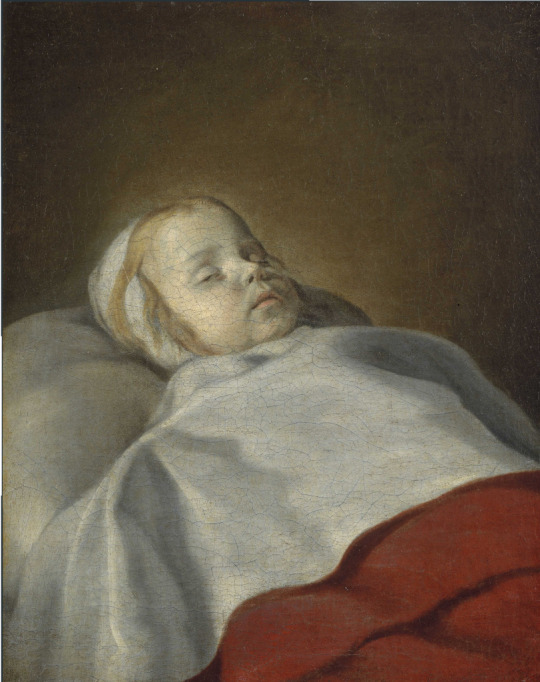
This poignant, tender and very beautiful picture is at the Musee des Beaux Arts at Besançon in France, where it hangs unattributed as a Portrait of a Dead Child, Flemish from the 17th century. Obviously it is a very personal painting, the work of a grieving parent. The artist brings us to the very edge of the bed where his child lies. Her eyes are nearly closed, the shape of them like the eyes of the boy in a drawing, below, at Berlin. Her hair is a pale flaxen colour, a lighter version of the yellow so often used by Vermeer, in the Lacemaker, for example, or the Girl with a Pearl Earring. There is a slight halo around her head. The folds of pillow and coverlet have a ghostly pallor, soft and unfocussed, like a mantle of snow. Most remarkable of all is the absence of ordinary daylight, the same absence one finds in Vermeer’s Servant asleep at a Table (at the New York Metropolitan Museum), except that the servant is merely asleep, but the child is gone into the darkness above her bloodless face, ashen now like the bedsheet. Under that sheet is a deep red blanket forming a triangle in the lower right corner of the picture.
It is the particular red of this blanket that alerts me to the possibility that the picture is a Vermeer. There are pictures by him that have no red in them at all, but this red, in deeper and lighter shades, is nevertheless a feature of his palette that recurs quite often. It is the red, for example, that we find in the jacket of the girl reading a score in The Girl Interrupted at Her Music at the Frick Collection in New York, and again in the Girl Drinking with a Gentleman, at Berlin. It is the colour of the roof tiles in The View of Delft, at the Mauritshuis, and of the skirt of the woman with her back to us, who stands at the virginals in the Royal Collection’s Music Lesson. Somewhat lighter, it is the red of the woman’s satin dress in the Couple with a Wine Glass, at Brunswick, and in two early works, the Edinburgh Christ in the House of Mary and Martha (where Mary wears it) and in the Dresden Procuress, in the jerkin of the man who fondles her breast. At Besançon the colour is deep and it speaks to us differently: in the presence of death it is an assertion, and reminder, of life, and life blood.
The comparisons made below, between the Besançon Dead Child, focus on two aspects of the former, the red of the blanket and the brownish background. Clearly the colours in reproductions vary in their fidelity to those in the originals; so, if there is merit in my attribution to Vermeer, it behoves those more acquainted with the originals, such as the curators of the current Vermeer exhibition at the Rijksmuseum in Amsterdam, to make their judgement accordingly. The hue of a red, or any colour, may be deeper or lighter. My argument relies on the red in question being essentially the same as what we find in his pictures, only in differing strengths. The colour of walls in Vermeer shows wonderful variations according to the degree of light falling on them. At Besançon there is, appropriately, a very subdued, ‘dead’ light, not the lively one that enters through a window.
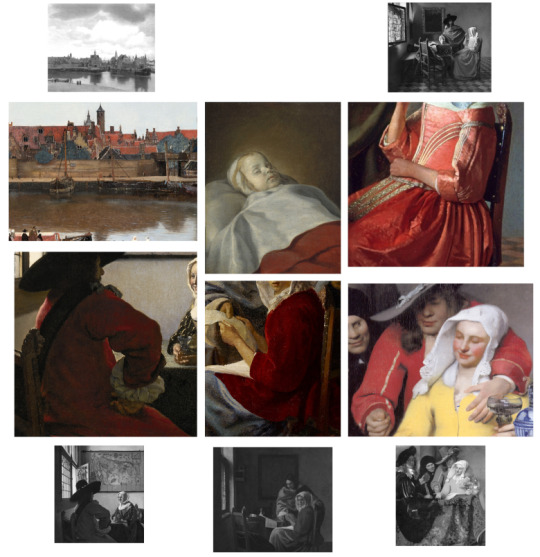
Clockwise from Top Left: View of Delft (Mauritshuis); Portrait of a Dead Child (Musee des Beaux Arts, Besançon); The Wine Glass (Gemäldergallerie Berlin); At the Procuress (Staatlichekunstsammlungen Dresden); Girl Interrupted at her Music; Officer and the Laughing Girl (Frick Collection)

Clockwise from top left: The Geographer (Städel Museum Frankfurt); Portrait of a Dead Child; Girl Reading a Letter (Gemäldegalerie Alte Meister Dresden); Young Woman Seated at a Virginal (National Gallery London); At the Procuress; Centre: Study of a Boy’s Head (Berlin Printroom)
As for the identity of the child, if this is indeed a Vermeer she must be one of the four daughters born before a son arrived in 1654; the approximate date of the picture, ‘circa 1650’, suggested by the Besançon Museum is therefore a reasonable guess.
The craquelure, it may be added, is also compatible with an attribution to Vermeer. The painting is on canvas and rather larger than one might expect (58 x 47.5 cm) for so intimate a scene.
I should add, by way of a concession to sceptics, that the argument here is not an easy one to make, because the very restricted content of the picture offers little with which to build it; around the head of the child only bedclothes and a blank wall. A blank wall by Vermeer is nevertheless different from a blank wall by Nicholas Maes or Pieter de Hooch.The case for attribution to Vermeer rests on features described above, and I hope they are enough when taken with what seems to be the case, that no other attribution has been suggested within mid-seventeenth century Netherlands that meets the obvious quality of this work.
The description just made, of the background in the picture as a ‘blank wall’ is not really correct; it is not a background, nor is it a wall, but rather an overtaking nothingness, the visual representation of absence and loss. Because Vermeer and his wife were fecund and had many children does not mean that the loss of any one of them was not a very sad occasion which he, as a painter, might well have wished to mark. If this painting is by him, as I am inclined to think, then it is further evidence that family was at the centre of his art, as of his life. He painted and celebrated the visible, the world of living light and shadow; sleep and death remove us from it, but what the sleeping servant and the dead child cannot see is still there to be seen and to be witnessed, albeit in a manner appropriate to those states, in a ‘dying of the light’.
#vermeer#lost paintings#dutch painter#painting#art history#studies in connoisseurship#connoisseurship
1 note
·
View note
Text
5 Must-See Art Exhibitions in September 2023!

Georgia O'Keeffe When: 10 Sep, 2023 – 29 Jan, 2024 Where: Museum of Modern Art (MoMA), New York To See Takes Time is a must-see for any fan of American art. The exhibition is beautifully curated and provides a comprehensive overview of O'Keeffe's career. The paintings are stunning and the curators have done a great job of highlighting O'Keeffe's unique vision. The MoMA is a world-class museum and is the perfect place to see this important exhibition. A World in Common When: 9 Sep, 2023 – 15 Jan, 2024 Where: Tate Modern, London A World in Common is a fascinating exhibition that explores the themes of identity, community, and belonging through the lens of photography. The photographs are powerful and moving, and the curators have done a great job of telling the stories of the photographers and the communities they represent. The Tate Modern is a great place to see this exhibition, as it is a museum that is committed to showcasing the work of contemporary artists from around the world. Célébration Picasso, La Collection prend des couleurs When: 16 Sep, 2023 – 22 Jan, 2024 Where: Centre Pompidou, Paris Célébration Picasso, La Collection prend des couleurs! is a celebration of the life and work of Pablo Picasso. The exhibition brings together over 200 works from the Centre Pompidou's collection, including paintings, sculptures, and drawings. The exhibition is a great opportunity to see Picasso's mastery of a wide range of artistic styles. The Centre Pompidou is a world-renowned museum of modern and contemporary art, and it is the perfect place to see this exhibition. Vermeer When: 23 Sep, 2023 – 28 Jan, 2024. Where: Rijksmuseum, Amsterdam Vermeer is a must-see for any fan of Dutch Golden Age painting. The exhibition brings together over 23 of Vermeer's masterpieces, including "Girl with a Pearl Earring." The paintings are exquisitely beautiful and the curators have done a great job of highlighting Vermeer's unique use of light and color. The Rijksmuseum is one of the finest museums in the world, and it is the perfect place to see this exhibition. Yayoi Kusama: Infinity Mirrors When: 29 Sep, 2023 – 28 Jan, 2024. Where: Guggenheim Museum Bilbao, Spain. Yayoi Kusama: Infinity Mirrors is an immersive exhibition that allows visitors to experience the world of Yayoi Kusama. The exhibition features some of Kusama's most iconic works, including "Infinity Mirror Room - The Obliteration Room." The exhibition is a truly unique experience and is a must-see for any fan of contemporary art. The Guggenheim Museum Bilbao is a stunning building and is the perfect place to see this exhibition. Overall, these are all excellent exhibitions that are well worth seeing. I highly recommend visiting any of these galleries if you have the opportunity. Read the full article
0 notes